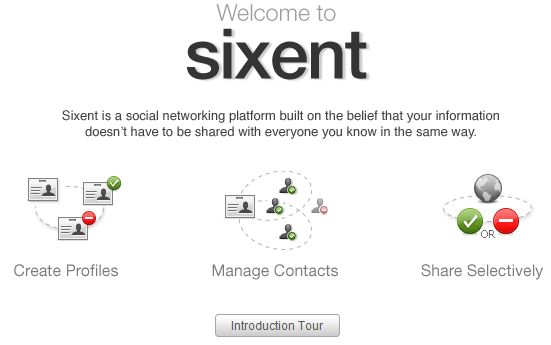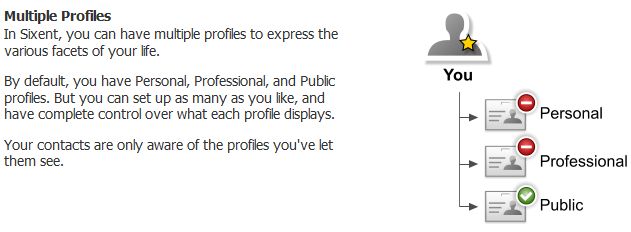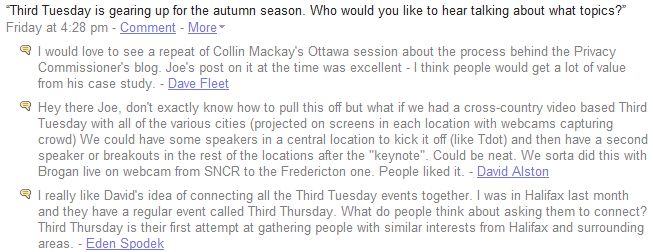I’ve posted another in the series of video interviews I’m doing with leaders of the Canadian public relations industry for the Canadian Council of Public Relations Firms. This month’s video is an interview with Dan Tisch, President of Argyle Communications.
What topics would you like to discuss at Third Tuesday this year?
 We’re extending the invitations to speakers for the first Third Tuesday Toronto and Third Tuesday Ottawa meetups of this autumn’s season.
We’re extending the invitations to speakers for the first Third Tuesday Toronto and Third Tuesday Ottawa meetups of this autumn’s season.
This year, we hope to feature some of Canada’s best new social apps and the developers and entrepreneurs behind them.
Who would you suggest that we invite to talk about their social apps or Canadian startups? Leave a comment here or in the Third Tuesday FriendFeed room.
Social Tools that let us down
There’s been some smart and engaging conversation by other bloggers in response to my Technorati and Me post about the decline of a social media tool I had once relied upon.
Shel Israel points out that it is inevitable and healthy that different tools will rise and fall as the social Web evolves: “Tools get better and we abandon old ones. … Following the evolution of tools is a good way to track the evolution of people all the way back to the time we lived in caves. Technorati made some mistakes as a company if you ask me, but what’s really relevant is that someone else came out with a better tool and people moved on.”
Neville Hobson, who started  the discussion with Shel Holtz on the FIR podcast 373 offered, “So my perception of Technorati now as a blog search tool is that it isn’t reliable any longer (although to be fair, I did a search just now, which did work). I end up Googling which, let’s face it, always works. And so I don’t use Technorati any more as a primary place to search. I still refer to Technorati when researching influencers online although I sometimes wonder how reliable that core aspect of its service really is, things like authority and ranking.”
the discussion with Shel Holtz on the FIR podcast 373 offered, “So my perception of Technorati now as a blog search tool is that it isn’t reliable any longer (although to be fair, I did a search just now, which did work). I end up Googling which, let’s face it, always works. And so I don’t use Technorati any more as a primary place to search. I still refer to Technorati when researching influencers online although I sometimes wonder how reliable that core aspect of its service really is, things like authority and ranking.”
Ari Herzog posts about his experience with Technorati: “What does it mean when I search on Technorati for “Michael Phelps” and find 11,030 results; whereas Google Blog Search provides 279,743?” I think it confirms that Technorati has fallen hopelessly behind.
Colin McKay riffs on his inability to stay faithful to any social media app. “I’m just a gigolo, baby. I’m looking for the short term hit, the thrill ride. … When it comes to online social media apps, I’ll grab on to something that’s functional and serves my needs. Is your app weak in some respect? Giddyup, I’m doubling up!”
Finally, Bob LeDrew carried the conversation forward with his reflections on two social apps that had let him down – Picassa -“my utter failure to get this to work, or to understand the benefits of it for me, after about three attempts at different times and on different machines, remains an unhealed wound” – and Pandora – “which I fell in absolute love with, and then closed off access to subscribers out of the United States.”
Do you have a story of a social media tool that you used to rely on but which let you down?
UPDATE:
Shel Holtz adds his own assessment of the problem with Technorati.
Dave Fleet adds FeedBurner to the list of disappointing services.
Technorati and Me
Sometimes it’s hard to admit that a longstanding relationship with a friend has withered to the point that it’s really just a memory. We cling to those memories of better time even though we don’t see one another day to day.  And when we do, it’s just not the same.
And when we do, it’s just not the same.
That’s the way it is with Technorati and me.
There was a time when I would visit Technorati several times a day. I would regularly refer to Technorati to learn about a new blog I’d discovered. What author had registered ownership of the blog? How many inbound links came to it and from whom?
A blog’s Technorati Authority would provide a quick indicator of whether a blog was being paid attention to and by whom.
The Technorati search engine provided me with a unique view of content. Not only could I find the most recent posts on any topic, but I could also filter them by the Technorati Authority – selecting posts from all blogs, those with a little authority, some authority or a lot of authority.
And Technorati first introduced me to the concept of persistent search. It was the first search engine I found that enabled me to define a search and then subscribe to the results in my feedreader – telling me right away about new content that satisfied my search criteria without having to regenerate the search terms.
I registered ProPR on Technorati and followed the increase of my own authority (Yes, I visited daily just to watch the number increase.) I even registered my Twitter stream with Technorati and was delighted to see its authority climb as others linked back to my Twitter ID.
I could even rely on Technorati’s then-CEO, David Sifry, to post a quarterly analysis of the state of the blogosphere/ live web.
So, Technorati meant a lot to me. It was a search engine, a reference point to assess the relative weight of blogs and a source of analysis and insight into the growth of social media.
But….
A relationship is only strong so long as both parties are committed to it. And over time, I began to feel abandoned by Technorati. Management changes, money problems, a loss of focus, failed partnerships, service outages – all took their toll. I began to rely less and less on Technorati.
 And just when my faith in Technorati was being challenged, Google enticed with its own social media search engine. I began to hang out more often with my new Google friend.
And just when my faith in Technorati was being challenged, Google enticed with its own social media search engine. I began to hang out more often with my new Google friend.
As I divided my loyalties, I noticed that the results from Google Blog Search was finding posts and content that Technorati was missing.
But my emotional attachment with my old friend Technorati kept me coming back. I’d continue to routinely set up persistent searches on both Google Blog Search and Technorati.
On top of this, Technorati was failing to maintain its innovation leadership. Technorati authority was the bluntest of instruments. But it had its own authority, being widely cited and incorporate in indexes like the AdAge Power150. But despite the fact that its many users criticized the basic methodology, Technorati failed to improve. It left the field wide open to startup AideRSS to make the big advance with its PostRank algorithm.
And so it ends…
Finally, I am throwing in the towel on Technorati. I no longer receive benefits that justify the time to go to the site and conduct a search. Google blog search reliably provides me with more complete results. So, why spend the time setting up and reviewing search results from a second service that has proven itself so unreliable?
And as I have come to doubt the completeness of Technorati’s search results, I’ve grown ever more reluctant to place any reliance on Technorati Authority.
So, at the end of the day, I find myself rarely going to Technorati.
The only time I use it now is when I am doing social media monitoring for a client. Why? Because as superior as it is, Google isn’t perfect. And Technorati is still better than the field of also-rans (Ice Rocket anyone?). And when I’m doing work for a client, i need a “second dip” to be sure that I haven’t missed anything. So, for now, I turn to Technorati as backup. A far humbler fate for Technorati than I had once expected for it.
How about you?
Are there social media tools and apps for which you once had high hopes that you now find yourself using and visiting less often? Tell us about it.
To get the ball rolling, I’m asked Dave Fleet, Bob LeDrew, Mitch Joel, Colin McKay and Shel Israel to tell us about a social media tools with which they once had a warm and deep relationship with that has now lapsed.
Credit where credit’s due
This post was inspired by Shel Holtz and Neville Hobson‘s discussion of Technorati’s unreliability on the FIR podcast 373.
Someone please tell Canada…
I’m sitting in Seattle at 8 AM local time (11AM Eastern) and this item has just come through in my Google Canada News feed:
Field Narrows for Obama’s Running Mate? Field Narrows? Boy, if that’s what Canadians are fed as up to date news, no wonder we have trouble with our relations with the U.S.
When I woke up two hours ago, I was greeted with this video from New Media Jim taken from Joe Biden’s front yard.
Sheesh. It’s 2008. We can all know what’s going on at the same time.
Hey Google, news should be timely. Not yesterday’s story posted today.
Where the Hell is Matt? At Gnomedex, of course!
![]() What makes Gnomedex such a special conference?
What makes Gnomedex such a special conference?
It marches to its own drummer – or at least the drummer of the crazy smart, unique Chris Pirillo. Every year, the speakers and participants at Gnomedex are like no other. If anything, it is regularly compared by attendees to Ted.
The speakers on the first day of Gnomedex this year included Danny Sullivan posing provocative questions about the intrusive potential of ubiquitous online search, Ben Huh providing the backstage story of the phenomenal success of icanhascheezburger, sixteen year old Web serial entrepreneur Mark Bao in a discussion about Generation Y with Boomer Francine Hardaway, Beth Kanter and Amanda Koster providing profoundly moving testimonials to our ability to use the Web to do good, conference attendees organizing a drive on Twitter that raised close to $3,000 within less than two hours to help send a Cambodian girl to school and artist Nathan Wade illustrating his use of 3D art to force us to think about … (OK, I have to admit that this one was just a step beyond my ability to keep up. And that`s good, because I want to be challenged beyond the same old same old.)
At what other conference could you find that range of imaginative, thought provoking presenters and subject matter? And that was just on the first day of the conference. (A hat tip to Maryam Scoble who this year worked with Chris and Ponzi Pirillo to assemble the speakers roster.)
And at what other conference would you expect this range of speakers to be featured in a single track? All conference attendees – academics, developers, marketers, Canadians, bloggers, uber geeks – participate in the same experience and share their different perspectives. Truly a unique learning experience.
And what other conference would close with Matt of Where the Hell is Matt fame leading the conference attendees in a mass dance on the conference stage?
If you didn’t make it to Gnomedex this year, take my word, you should plan to attend next year. You won’t be disappointed. Gnomedex is a unique conference that is sure to stimulate your creativity.
Ramius’ Philippe Dame talks about the Sixent social networking platform
 Yesterday, I posted about the very positive experience I’ve had trying out the beta of the new social networking platform, Sixent.
Yesterday, I posted about the very positive experience I’ve had trying out the beta of the new social networking platform, Sixent.
It’s not surprising how good Sixent is right out of the gate if you consider that Ramius has had extensive experience with online collaboration. Its Community Zero product has been in use by corporations and organizations for almost a decade. They’ve clearly applied the insight they gained through Community Zero in building a user friendly, intuitive, functional and fun social network platform.
 Philippe Dame, Ramius’ C.O.O., sat down with me recently to talk about Sixent and what he believes makes it stand out.
Philippe Dame, Ramius’ C.O.O., sat down with me recently to talk about Sixent and what he believes makes it stand out.
In creating Sixent, the Ramius’ team’s objective was to “create a social network in which people could share their life the way they want to and connect with people in a meaningful way.” The key to their approach to this is to provide Sixent users with a “lot of control over how they connect with people,” explains Philippe. This translates into “how they disclose their own information and how they disclose content to people.”
“We’ve tried to emulate exactly how people want to present their own personas online. We all operate personal and professional sides. Now with social media and the Web, we’re becoming more familiar with having a public side – be it a Twitter feed or other kinds of services. We want to provide you with adequate ability to segment what you would say and show about yourself, and do so in a really easy to use way.” Philippe suggests that Sixent’s approach to enabling users to show different profiles to different people, “provides a degree of control that is unprecedented.”
“With our heritage in enterprise collaborative software, we are taking it to a corporate market in the fall,” Philippe says. “The idea of categorizing your contacts and having multiple profiles plays well in terms of people’s dual roles of interacting with their colleagues as well as dealing with partners and customers that go outside the firewall. People don’t want to join multiple social networks. So, if they can have a single dashboard and identity, and achieve these things in a controlled way, we think we’ve got a success on our hands.”
“This is an environment in which you are trying to provide a utility to your users so that different kinds of interactions can take place that weren’t previously possible. If they can connect that back to a growing public network, it can provide both great utility for the organization in terms of a deeper reach into the social graph of their own customers and partners. It can also work on the reverse, where users are now able to interact on a personal level in a kind of sister network and be getting more utility from it and therefore coming back on a regular basis, really solving the key adoption issue of getting people to be on your network and to be productive people there.”
First impression of Sixent: A winning social networking platform with a twist
Community managers, marketers and communicators have a new community building tool.
 Ottawa-based Ramius has pulled the wraps off its new social networking platform, Sixent.
Ottawa-based Ramius has pulled the wraps off its new social networking platform, Sixent.
I’ve been testing the Beta. And so far, I’m very impressed with this platform. I think it has a potential to be an industry leader.
Right off, I was struck by how easy Sixent is for a new user to master. The first thing that hit me when I signed on for the first time was the outstanding tutorials and demonstrations. There’s a popup help and tutorial box that explains the features of Sixent and guides new users through every task they might want to perform in order to make use of the community.
Once you’re past the basics, everything is intuitive, easy to use and the information you want is where you’d expect it to be.
New users are asked to create three profiles – personal, professional and public. This is easier than it sounds. A neat feature of the set up screen enables you to set up the basic information that you’d like to make available in your public profile and then copy it with one click to your professional and personal profiles. You can then enter the additional information you want to share with people who you will let see each profile. In my case, for example, I share my age with friends who have access to my personal profile, but now with those who can only see my business profile. Sixent makes this incredibly easy to set up and then use. It took me less than 10 minutes to set up all three profiles.
The software also lets users add additional profiles. So I set up a “social media” profile that includes additional information about my geeky side that will only be meaningful to the people who read my blog and share my interest in social media and online community.
Sixent is aimed squarely at the enterprise market. However, the developers at Ramius have designed it to be familiar and intuitive to people already on Facebook and the other mass consumer social networking sites. This design approach will make it very easy for corporations to use it as a platform for social networks inside and outside the organization, as users will be able to immediately begin to use an interface that seems very familiar.
Let’s try it together
The only problem I have so far with Sixent? There isn’t a very big community there. However, that can be fixed pretty easily. All that has to happen is for you and others to join and try it out.
If you want to try out Sixent, I’m “thornley.” Add me as a contact on sixent and let’s explore its usefulness together.
Join the conversation in the Third Tuesday FriendFeed Room
 I’ve set up a FriendFeed Room for the Third Tuesday social media meetups. I hope that this will be a place where Third Tuesday participants will gather to discuss the topics explored at each event, speakers you’d like to hear from, things you’d like to learn more about, and offer feedback and suggestions regarding the events themselves.
I’ve set up a FriendFeed Room for the Third Tuesday social media meetups. I hope that this will be a place where Third Tuesday participants will gather to discuss the topics explored at each event, speakers you’d like to hear from, things you’d like to learn more about, and offer feedback and suggestions regarding the events themselves.
Shel Holtz and Neville Hobson have had great success in building a community engaged in sharing and discussion in their FIR Room on FriendFeed.
I’ve attempted to do the same thing with a Third Tuesday Facebook group. But frankly, I’ve found it to be an uphill battle to stimulate content in the Facebook group.
So, it’s time to try FriendFeed. I’ve already found that it’s easy to get a discussion going with my first question on the FriendFeed room. On Friday, I asked about possible speakers and topics. Within the next couple hours I heard from three Third Tuesday members Dave Fleet (yes, we work together), David Alston (yes, I use his product) and Eden Spodek (yes, I love her site.)
We’ll continue to announce the Third Tuesday Toronto and Third Tuesday Ottawa events on Meetup.com. Meetup has the tools necessary to easily and quickly organize and manage meetings. However, it’s conversation tools are not strong.
So, if you haven’t done so already, click over to the Third Tuesday FriendFeed Room and join the conversation.
Who would you like to hear talk about what they are doing in social media / Web 2.0?
Who would you like to hear speak at a Third Tuesday social media meetup or the Social Media Breakfast?
 The volunteers organizing the Ottawa Third Tuesday and Toronto Third Tuesday and Social Media Breakfast are reaching out to our contacts to in order to put together this season’s program. We’re looking for speakers who
The volunteers organizing the Ottawa Third Tuesday and Toronto Third Tuesday and Social Media Breakfast are reaching out to our contacts to in order to put together this season’s program. We’re looking for speakers who
- have something unique and thought provoking to say about social media;
- are developing social Web apps; or
- have applied it to community building, communication, public relations or marketing.
Of course, the quality of an event series is driven by the participation of the people who attend. So, we want to invite speakers who you you want to hear address the topics that you find interesting.
We’ve had some great speakers in the past, including: Shel Israel, Shel Holtz, Richard Binhammer, Mathew Ingram, Michael Geist, Mark Evans, Colin McKay, Anthony Williams, Rob Hyndman, Michael McDerment, Saul Colt, Katie Paine, Marcel LeBrun, Stephen Taylor, Paul Wells, Marshall Sponder, Mitch Joel, Alex and Ali de Bold, Darren Barefoot, Jesse Brown, Brendan Hodgson, Giovanni Rodriguez, Danielle Donders, Ryan Anderson, Marc Snyder, David Jones, Terry Fallis, Julie Rusciolelli, Keith McArthur and Martin Waxman.
We’ve established a tradition of great speakers and strong participation from attendees. Please help us to continue in this way. Let us know who you’d like to hear from and what topics you’d like to have addressed.




